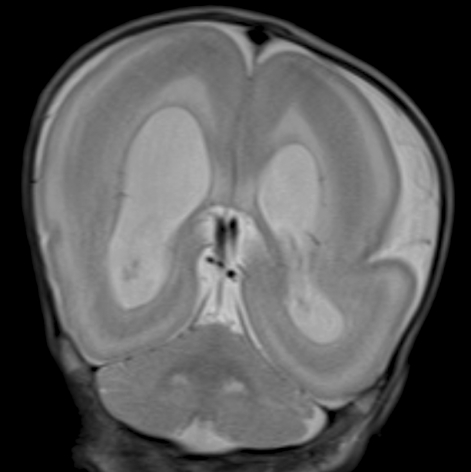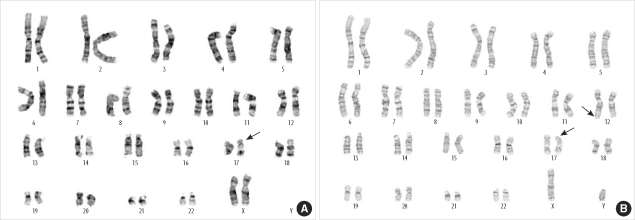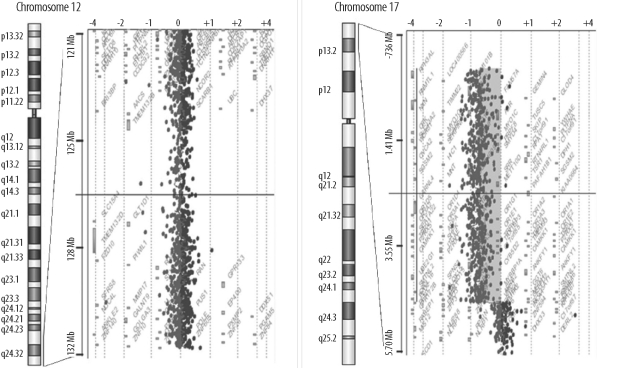1. Reiner O, Carrozzo R, Shen Y, Wehnert M, Faustinella F, Dobyns WB, et al. Isolation of a Miller-Dieker lissencephaly gene containing G protein beta-subunit-like repeats. Nature. 1993; 364:717–721. PMID:
8355785.
2. Schwartz CE, Johnson JP, Holycross B, Mandeville TM, Sears TS, Graul EA, et al. Detection of submicroscopic deletions in band 17p13 in patients with the Miller-Dieker syndrome. Am J Hum Genet. 1988; 43:597–604. PMID:
2903661.
3. Sharief N, Craze J, Summers D, Butler L, Wood CB. Miller-Dieker syndrome with ring chromosome 17. Arch Dis Child. 1991; 66:710–712. PMID:
1711306.

4. van Zelderen-Bhola SL, Breslau-Siderius EJ, Beverstock GC, Stolte-Dijkstra I, de Vries LS, Stoutenbeek P, et al. Prenatal and postnatal investigation of a case with Miller-Dieker syndrome due to a familial cryptic translocation t(17;20) (p13.3;q13.3) detected by fluorescence in situ hybridization. Prenat Diagn. 1997; 17:173–179. PMID:
9061768.
5. Guerrini R, Filippi T. Neuronal migration disorders, genetics, and epileptogenesis. J Child Neurol. 2005; 20:287–299. PMID:
15921228.
6. Thomas MA, Duncan AM, Bardin C, Kaloustian VM. Lissencephaly with der(17)t(17;20)(p13.3;p12.2)mat. Am J Med Genet A. 2004; 124A:292–295. PMID:
14708103.

7. Grosso S, Fichera M, Galesi O, Luciano D, Pucci L, Giardini F, et al. Bilateral periventricular nodular heterotopia and lissencephaly in an infant with unbalanced t(12;17)(q24.31; p13.3) translocation. Dev Med Child Neurol. 2008; 50:473–476. PMID:
18384621.

8. Cardoso C, Leventer RJ, Ward HL, Toyo-Oka K, Chung J, Gross A, et al. Refinement of a 400-kb critical region allows genotypic differentiation between isolated lissencephaly, Miller-Dieker syndrome, and other phenotypes secondary to deletions of 17p13.3. Am J Hum Genet. 2003; 72:918–930. PMID:
12621583.

9. Dobyns WB, Curry CJ, Hoyme HE, Turlington L, Ledbetter DH. Clinical and molecular diagnosis of Miller-Dieker syndrome. Am J Hum Genet. 1991; 48:584–594. PMID:
1671808.
10. Mignon-Ravix C, Cacciagli P, El-Waly B, Moncla A, Milh M, Girard N, et al. Deletion of YWHAE in a patient with periventricular heterotopias and pronounced corpus callosum hypoplasia. J Med Genet. 2010; 47:132–136. PMID:
19635726.

11. Bao L, Schorry EK. A girl with partial trisomy 12q24.31 inherited from her father and a possible novel syndrome transmitted from her mother. Am J Med Genet A. 2005; 138:361–364. PMID:
16222678.

12. Schoumans J, Sanner G, Nordenskjold M, Anderlid BM. Detailed clinical description of four patients with 1.3 and 2.1 Mb chromosome imbalances derived from a familial t(12;17)(q24.33;q25.3). Am J Med Genet A. 2005; 134:254–258. PMID:
15704131.

13. Sathanoori M, Hu J, Murthy V, Byrnes A, Vockley J, Safier R, et al. Cryptic duplication of 12q24.33→qter in a child with Angelman syndrome-simultaneous occurrence of two unrelated cytogenetic events. Am J Med Genet A. 2007; 143A:985–994. PMID:
17394213.

14. Coe BP, Ylstra B, Carvalho B, Meijer GA, Macaulay C, Lam WL. Resolving the resolution of array CGH. Genomics. 2007; 89:647–653. PMID:
17276656.

15. Miller DT, Adam MP, Aradhya S, Biesecker LG, Brothman AR, Carter NP, et al. Consensus statement: chromosomal microarray is a first-tier clinical diagnostic test for individuals with developmental disabilities or congenital anomalies. Am J Hum Genet. 2010; 86:749–764. PMID:
20466091.

16. Hochstenbach R, van Binsbergen E, Engelen J, Nieuwint A, Polstra A, Poddighe P, et al. Array analysis and karyotyping: workflow consequences based on a retrospective study of 36,325 patients with idiopathic developmental delay in the Netherlands. Eur J Med Genet. 2009; 52:161–169. PMID:
19362174.

17. De Gregori M, Ciccone R, Magini P, Pramparo T, Gimelli S, Messa J, et al. Cryptic deletions are a common finding in "balanced" reciprocal and complex chromosome rearrangements: a study of 59 patients. J Med Genet. 2007; 44:750–762. PMID:
17766364.

18. Shin YB, Nam SO, Seo EJ, Kim HH, Chang CL, Lee EY, et al. Partial trisomy 1q41 syndrome delineated by whole genomic array comparative genome hybridization. J Korean Med Sci. 2008; 23:1097–1101. PMID:
19119457.






 PDF
PDF ePub
ePub Citation
Citation Print
Print





 XML Download
XML Download